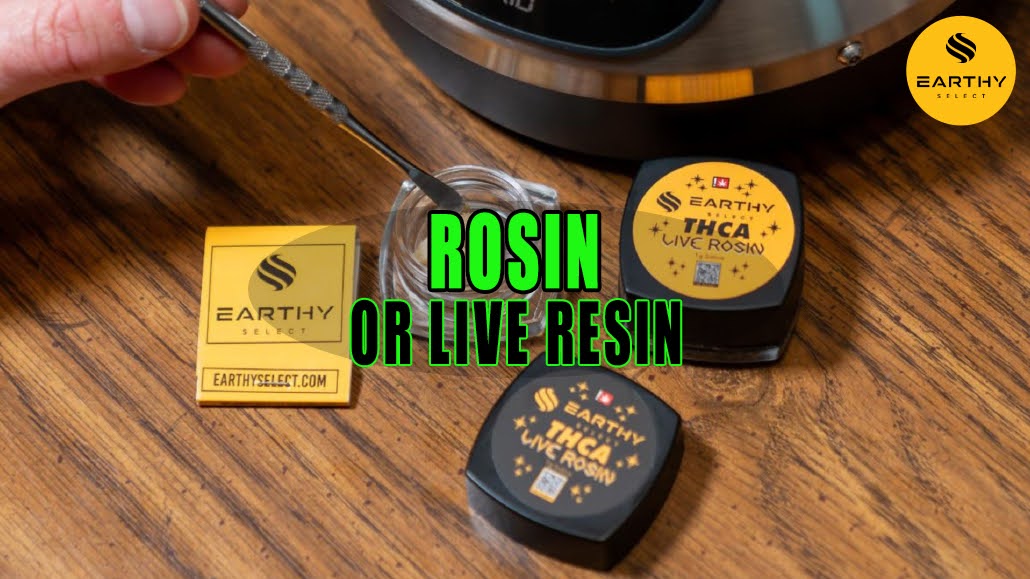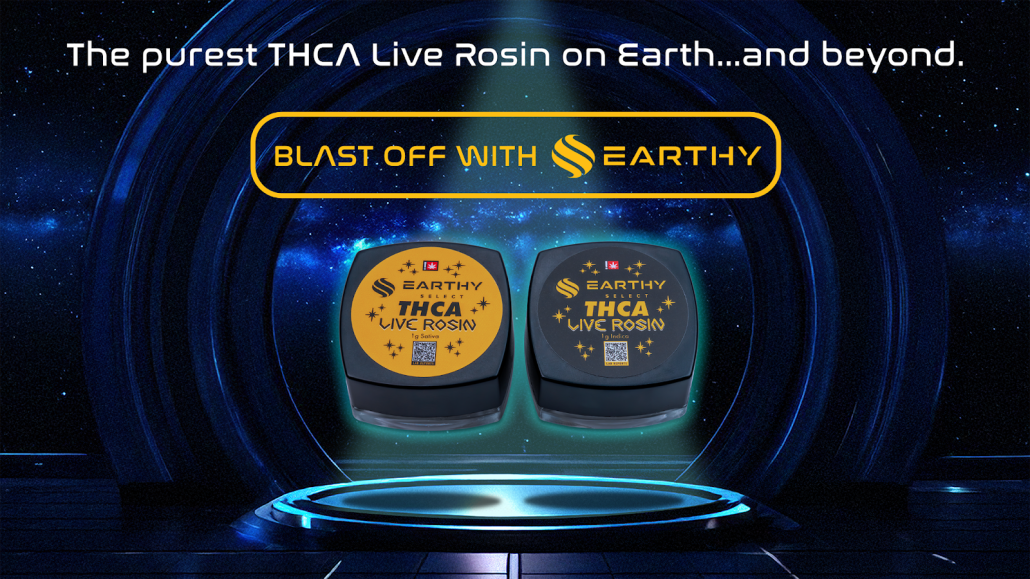Rosin or Live Resin? We Break Down the Dab Debate
In the ever-evolving world of cannabis concentrates, the clash between rosin and live resin has sparked heated discussions among enthusiasts and newcomers alike. It’s a debate steeped in science, preference, and the pursuit of the purest, most potent experience—a quest that mirrors the meticulous craftsmanship behind every product at Earthy Select. As a cannabis science company dedicated to federally compliant THC innovations, we’re diving deep into this showdown to dissect the processes, profiles, and practicalities of these two heavyweights in the dabbing arena. Our mission? To empower you with knowledge, ensuring that whether you’re chasing bold flavors or scalable effects, you can select your cannabis adventure with confidence.
At Earthy Select, we’re not just observers in the cannabis space; we’re pioneers. With our organically grown products cultivated on family farms and state-of-the-art indoor facilities in California and Colorado, we uphold the highest standards of quality, safety, and compliance. For instance, our THCa flower, boasting 20-30% total cannabinoids, exemplifies our commitment to potency and reliability. So, as we unpack the nuances of live resin vs rosin, know that this isn’t just a casual comparison—it’s a science-driven exploration grounded in our ethos of crafting the best consumer cannabis goods on the market. Let’s cut through the haze and help you decide which concentrate reigns supreme for your next session.
How Rosin Is Made: A Solventless Path
The art of making live rosin includes a solventless technique that merges simplicity with a scientific edge. However, the starting point is top-notch cannabis, frozen to lock in its aromatic terpenes. Once it’s wrapped in parchment paper, it’s ready for the next step.
Enter the heat press: delivering just the right balance of warmth (between 180°F and 220°F) and pressure, it coaxes the rich oils from the plant, leaving impurities behind. It’s a delicate dance of temperature and timing, pressing no longer than 90 seconds to safeguard quality [1].
The reward? A beautiful, amber-hued rosin, redolent with the strain’s natural flavor and potent with THC levels hitting the 60-80% mark, though this can vary depending on the starting material and extraction accuracy [2]. It’s a nod to the beauty of tradition, enhanced by precision—yielding a pure, potent expression of the cannabis plant.
Starting with High-Quality Flower
When it comes to crafting the perfect dab, it all begins with the foundation: premium cannabis flower. Sure, advanced extraction techniques matter, but they can’t compensate for low-grade starting material. Top-notch flower shines with high cannabinoid percentages and diverse terpene profiles, essential for delivering those delicious flavors and potent effects. Remember, a dab’s excellence is directly tied to the flower’s purity and potency—tested to ensure you’re not inhaling anything but the best.
The distinction between live rosin and live resin further underscores the centrality of flower quality. For live resin, preserving the just-harvested freshness is key, as it captures the plant’s essence through flash-freezing and chemical refinement. In contrast, rosin relies on heat and pressure to extract from either cured flower, hash, or, in the case of live rosin, fresh-frozen flower. The latter comprises the highest-grade botanicals. The simple truth is, no matter your preference, without quality from the get-go, you won’t reach those lofty peaks of dabbing bliss. Make sure your cannabis is cultivated and processed with the utmost care—because what’s the point if it isn’t the good stuff?
Applying Heat and Pressure
While both rosin and live resin involve heat and pressure in their production, the approaches differ significantly. Rosin relies on a straightforward, solventless method that utilizes heat (typically 180-220°F) and pressure to extract a terpene-rich, flavorful concentrate from the cannabis plant. This process, rooted in physical principles without the use of chemicals, often yields a purer product; however, it may be more labor-intensive due to its lower output [1].
Live resin, by comparison, incorporates solvents. It begins with fresh, flash-frozen cannabis and employs a closed-loop system with solvents such as butane or propane for extraction. Manufacturers generally use lower temperatures (often 80-120°F) to preserve terpenes. Ultimately, this method aims to capture the plant’s characteristics at the time of harvest, though it involves complex equipment and procedures [3].
In summary, both rosin and live rosin emphasize simplicity and a traditional approach, while live resin leverages contemporary techniques and solvents. In contrast to rosin made from dried flowers, live rosin uses fresh, flash-frozen flower, similar to live resin, retaining the peak state of the flower.
Collection and Storage Tips
Collecting and storing your rosin or live resin properly is crucial to maintain its quality. When pressing rosin, quickly transfer it to parchment paper to minimize exposure to air, which can cause oxidation and reduce the extract’s flavor and potency. For live resin, ensure it comes in airtight, opaque containers to protect against the damaging effects of light and oxygen.
As for storage, a cool, dark place is ideal; aim for a temperature of 55-60°F, which a fridge can usually provide. Avoid using freezers for short-term storage, as they can alter the texture of your concentrates. Choose silicone or glass containers with tight seals over plastic, which can degrade and contaminate your goods. Keep in mind that cannabinoids can break down in temperatures over 70°F, so prioritize a cooler environment [4].
Limit how often you open your storage containers to reduce air exposure. Keep your dab tools clean, and consider divvying up your stash into smaller amounts to keep the rest pristine. Ultimately, a little extra effort in handling your concentrates goes a long way in preserving their quality for those perfect dabbing experiences.
How Live Resin Is Made: Freezing Fresh for Flavor
Like live rosin, live resin distinguishes itself in the cannabis concentrate realm by starting with a key step: flash-freezing the plant immediately after harvest to retain its full flavor profile. Many regard this process as vital for preventing the degradation of delicate terpenes and cannabinoids. By subjecting the buds to temperatures often below -40°F, manufacturers can preserve the aromatic qualities in a state that closely resembles their fresh condition [3].
Following this step, the frozen material undergoes extraction using solvents such as butane or propane. These solvents are generally effective at isolating a wide range of compounds without significantly altering their properties, though the process requires a controlled environment due to the solvents’ flammability [5].
The end product is a concentrate that appears to reflect the characteristics of the original plant, often described as a flavorful and aromatic snapshot of its peak qualities. With a rich terpene profile, live resin is frequently noted for providing a nuanced experience for those seeking authenticity and strength in their dabs [6]. However, the use of solvents deters some purists from the end product.
Fresh Frozen Flower Basics
Picture the peak perfection of a cannabis bud, its flavors and effects primed for enjoyment. That’s the allure of fresh frozen flower. By swiftly freezing the buds post-harvest, their aromatic terpenes and potent cannabinoids are perfectly preserved. This method trumps traditional drying, safeguarding the bud’s full-bodied profile.
For connoisseurs creating cannabis concentrates like live resin and live rosin, fresh frozen is the gold standard. It guarantees a terpene-packed, flavorful concentrate, true to the plant’s original character. Notably, solventless rosin, made from fresh, flash-frozen flower, often referred to as “live rosin,” can yield a diverse terpene profile, potentially offering a more balanced and potent experience [3] [1].
Hydrocarbon Extraction and Purging
Hydrocarbon extraction is the go-to method for creating live resin, typically using butane or propane to capture the full spectrum of cannabinoids and terpenes from fresh-frozen cannabis. It’s a delicate dance of chemistry—get it right, and you have a potent, flavor-packed concentrate; miss a step, and unwanted solvent residues may linger. The closed-loop system is key here, as it isolates the process and reduces risks. Then, the crucial purging phase heats the extract, vaporizing the solvent without damaging those volatile terpenes. Safety is paramount, with rigorous monitoring to ensure solvent levels fall below the 500 parts per million safety threshold [5].
Yet, the complexity and flammability of hydrocarbon extraction raise concerns. There’s no denying the horror stories of DIY disasters. Professional outfits, such as those at Earthy Select, avoid these dangers with advanced equipment and safety protocols. Still, the question endures: do the benefits outweigh the risks, especially when solvent-free alternatives like live rosin pressing are available? The allure of live resin is tangible, with THC concentrations reaching 70-90% and terpenes at 5-10%, but the specter of residual solvents is a point of contention for those emphasizing purity above all else [6]. For this reason, many cannabis concentrate connoisseurs opt for live rosin, as it meets or exceeds the nuanced purity of live resin due to its fresh flash-freezing process while avoiding solvents.
Taste, Texture, and Terpenes: How They Compare
For lovers of cannabis concentrates, the battle rages on: rosin versus live resin. Or, many have come to champion the purity of live rosin. When it comes to taste, think of live resin and live rosin as the zesty essence of the plant, derived from fresh-frozen flora to preserve those delicate, aromatic terpenes. Rosin presents a richer, more earthy palate than resin, extracted purely through heat and pressure sans solvents [6]. Both options, if formulated correctly, with high-quality cannabis, capture the fragrance of a garden in full bloom.
Texture-wise, live resin is akin to a viscous, sticky honey, while rosin’s consistency ranges from creamy butter to a fragile, shatter-like quality, depending on the finesse of the extraction process. Lastly, terpenes – the heroes of scent and subtlety – are abundant in live resin that’s meticulously extracted, offering nuanced effects and a high-fidelity taste profile. Rosin also contains terpenes, but may lose some of them to the heat of extraction [1] [6].
In essence, if nuanced flavors are your chase, and you don’t mind a bit of messiness, live resin is your go-to. On the flip side, if you’re seeking a solvent-free experience with a solid texture and flavorful strain-specific notes, live rosin is the way to go. Each has its own charm that caters to different preferences, leaving the choice between the two as a matter of personal taste and priority.
Common Terpene Profiles in Rosin and Live Resin
In the realm of cannabis concentrates, terpenes play a significant role in shaping the distinct flavors and effects of rosin and live resin. Rosin, produced through heat and pressure, often reflects the terpene profile of its source flower. Common terpenes, such as limonene with its citrus notes or myrcene with its earthy tone, may be present [1].
Similarly, live resin captures a broad spectrum of terpenes, due to the freezing of fresh flower before extraction. It often features terpenes such as pinene, which has a pine-like aroma, and caryophyllene, which has a spicy character. It may also preserve terpinolene, which contributes fruity notes that might be less prominent in rosin made with dried flower [6].
Both live resin and live rosin may contain high terpene percentages, often ranging from 5-10% by weight in premium offerings. For those seeking a natural, solvent-free concentrate, rosin remains a viable option. Both resin and rosin may share terpenes, such as humulene and ocimene. While live resin may appear to reflect the plant’s essence, live rosin might be seen as a distillation of the plant at its peak state [2][6]. Whether drawn to the depth of live resin or the purity of rosin, connoisseurs often tailor their cannabis experience around terpenes.
Texture, Color, and Consistency
Cannabis concentrates exhibit a variety of textures, colors, and consistencies. For example, live resin often presents a sticky, golden-amber appearance, which may indicate a rich terpene content derived from fresh-frozen material. Its texture is generally soft and workable, likely due to the cold extraction process [3].
Rosin, by contrast, can appear glossy, resembling wax, depending on production methods. Its color typically ranges from light yellow to deep amber, reflecting the quality of the source material and extraction technique. Rosin is often noted for its drier consistency, which may make it easier to handle; however, it can harden if not appropriately stored [1].
These visual and tactile characteristics may offer insight into the craftsmanship behind the concentrate. Live resin often suggests a flavor-rich potential, while rosin is associated with a cleaner, solvent-free profile. Ultimately, their value is often found in the balance of flavor and effect they provide.
How to Choose the Right Dab for You
Between live resin’s lush terpene profile and rosin’s commitment to solventless purity, your dabbing preference narrows down to personal taste. At Earthy Select, we take pride in offering top-tier, lab-tested concentrates, including premium live rosin. Indeed, our products, grown organically in the United States, ensure a safe and high-quality experience, whether you opt for the aromatic intensity of live resin or the clean, terpene-rich vibes of live rosin.
With our carefully curated selection, you’re not just choosing a concentrate; you’re embarking on an elevated cannabis journey. So, dip into Earthy Select for a dab experience that’s not just about consumption, but about exploration and discovery. Select your adventure, and trust us to provide the perfect companion for your taste and preference in the world of THC.
Flavor-Seeking Dabbers
Thanks to the flash-freezing process used right after harvest, live resin captures an incredibly vibrant, true-to-plant taste—often described as bold, juicy, and complex. It’s ideal for those who love low-temp dabs and want to savor the essence of the cultivar.
Rosin, especially live rosin, also ranks high in the flavor department. Solventless extraction can retain delicate terpenes that get lost in hydrocarbon processes, resulting in a clean, sometimes more “natural” taste [1]. Indeed, rosin’s flavor can be more subtle or earthy compared to the punchier taste of live resin. Notably, live rosin extraction is more intensive and time-consuming than live resin extraction, often resulting in a more complex and nuanced flavorprofile, a smoother consumption experience, and a cleaner, more robust product.
Potency and Therapeutic Use
In terms of potency, both rosin and live resin deliver notable effects, though their approaches may differ. Live resin often features high THC levels, typically ranging from 65-85% in well-crafted products, and may provide a quick onset, potentially appealing to recreational users seeking euphoria, creativity, or relaxation. Some sources suggest that it may also be beneficial for those seeking rapid relief from symptoms such as pain or nausea [2]. However, more research is needed.
Likewise, live rosin, particularly full-spectrum varieties, may offer a wider range of cannabinoids and terpenes, which some suggest can enhance the entourage effect. Also, live rosin’s true-to-strain flavor appeals to fans of particular cultivars. For individuals managing chronic conditions or with sensitivities, solventless rosin may provide reassurance and a gentle yet potent option, free from solvent traces [1].
Budget, Convenience, and Access
Live resin is generally more affordable and easier to find, thanks to scalable production and wide availability in legal markets. It’s a great choice if you want flavor and potency without breaking the bank [2].
Live rosin, on the other hand, is the premium option—solventless and small-batch. For those who value clean extraction and artisan quality with lush terpene profiles, it’s a worthy investment.
Both concentrates can be used with dab rigs, pens, or vaporizers, but rosin also appeals to DIY enthusiasts who enjoy pressing their own [1].
Final Thoughts
Whether you lean toward crisp, flavorful live resin or the clean, solventless appeal of rosin, the right choice depends on your goals—be it flavor, effects, or experience. At Earthy Select, we’re here to elevate every session with premium, lab-tested concentrates you can trust.
🛒 Explore our collection and discover what your next favorite dab feels like.
Frequently Asked Questions: Live Resin vs Rosin
Which has a better flavor profile, rosin or live resin?
Live resin is often noted for a more pronounced flavor profile, likely due to the fresh-frozen extraction method that preserves a comprehensive terpene range mirroring the original flower. In contrast, rosin, while offering a clean taste, may not always match the depth of live resin [6]. At Earthy Select, we strive to ensure that all our concentrates deliver high-quality flavor.
Does rosin or live resin have a longer shelf life?
Rosin might have a marginally longer shelf life as a solventless extract, potentially less susceptible to rapid degradation of certain compounds. However, proper storage conditions are generally critical for both, as exposure to heat, light, and air could impact terpenes and cannabinoids. Earthy Select employs rigorous testing and quality measures to support optimal shelf life for our products [4].
Which is better for medical users, rosin or live resin?
For medical users, rosin (or live rosin) is generally considered better than live resin due to its solventless extraction process, which eliminates concerns about residual solvents and impurities. While both offer high potency and full-spectrum experiences, the absence of solvents in live rosin makes it a cleaner and potentially safer option for those seeking therapeutic benefits [7]. Earthy Select offers products with customizable potency to meet a wide range of wellness needs.
What equipment do you need to consume rosin or live resin?
Consuming rosin or live resin typically requires a dab rig, e-rig, or vaporizer specifically designed for concentrates. Dab tools and a torch (or electronic heating element) are often used with rigs. For portability, many vape pens are compatible with both live resin and rosin pods or cartridges.
Which is more convenient for discreet use, rosin or live resin?
Rosin may be more convenient for discreet, portable use due to its generally stable texture. Live resin, with its stickier consistency, might require cooler conditions to maintain form. At Earthy Select, our concentrates are carefully crafted for ease of use, supporting discreet enjoyment, regardless of the selection.
How does the texture of rosin compare to live resin?
In terms of texture, rosin is often more shatter-like or waxy, making it relatively easy to handle, while live resin tends to have a gooey, sticky consistency that may be less manageable [1]. At Earthy Select, we focus on maintaining consistent quality and texture across our concentrates to ensure a dependable experience.
Do rosin and live resin have different wellness benefits?
Both concentrates offer significant potency. Rosin, valued for its purity, and resin for its affordability, offer flavorful options with varying effects and wellness benefits. Some users enjoy the solventless quality of rosin knowing that chemical solvents are not used. Earthy Select products are designed to support both wellness and recreational goals with tailored potency.
What types of cannabis strains are best for making rosin or live resin?
At Earthy Select, strains such as LA Kush Cake, Sunday Driver, and Cereal Milk are often considered ideal for producing rosin or live resin. These varieties are typically rich in terpenes and cannabinoids, making them suitable for creating flavorful, potent extracts, especially when harvested fresh or flash-frozen.
Medical Disclaimer / Legal Disclaimer – Information is provided for educational purposes only. It does not, and is not intended to, constitute legal advice or medical advice. We strive to be accurate and up-to-date, but the legality of cannabinoids and the science of cannabis are continually evolving. The author is neither a legal professional nor a medical expert. Before buying or using any products, you should consult with your local authorities and medical providers.
References:
- LivWell. Rosin vs Resin: Extraction Methods, Potency, Effects. Available from: https://livwell.com/blog/rosin-vs-resin [Accessed 2025-06-11]
- Jersey Meds. Live Resin vs Rosin vs Distillate: Key Differences 2025. Available from: https://jerseymeds.com/blog/live-resin-vs-rosin-vs-distillate-differences/ [Accessed 2025-06-11]
- Sunnyside Dispensaries. Live Resin vs Rosin. Available from: https://www.sunnyside.shop/learn/live-resin-vs-rosin [Accessed 2025-06-11]
- Eclipse Cannabis. Live Resin vs. Rosin: Key Differences Explained. Available from: https://eclipsecannabis.com/live-resin-vs-live-rosin-understanding-the-key-differences-and-choosing-the-right-one/ [Accessed 2025-06-11]
- EVN CBD. Live Resin vs Rosin vs Distillate: What’s the Difference Between These Concentrates? Available from: https://evn-cbd.com/blogs/the-evn-digest/live-resin-vs-rosin-vs-distillate [Accessed 2025-06-11]
- Moose Labs LLC. Rosin vs Resin? What’s The Difference? Available from: https://mooselabs.us/blogs/news/rosin-vs-resin [Accessed 2025-06-11]
- Root Sciences. Live Rosin vs Live Resin: What is the Difference? https://www.rootsciences.com/blog/live-rosin-vs-live-resin-difference/ [Accessed 2025-06-16]






